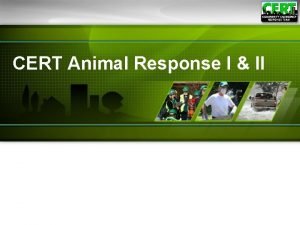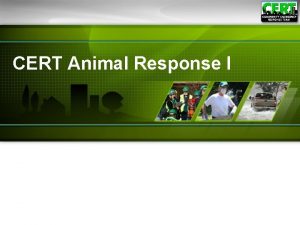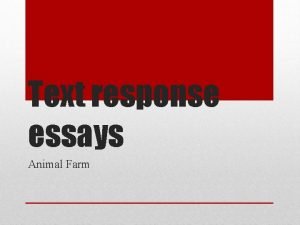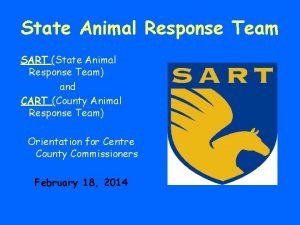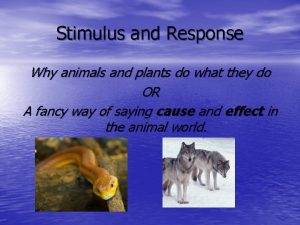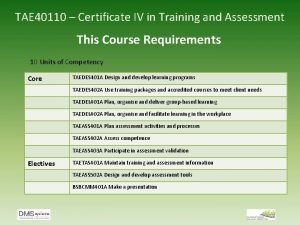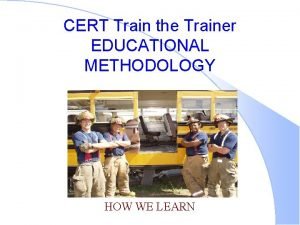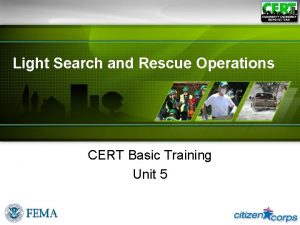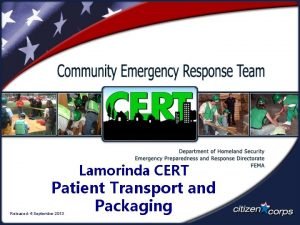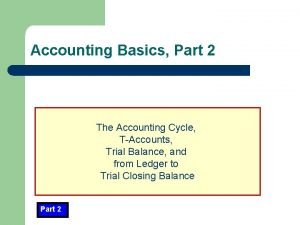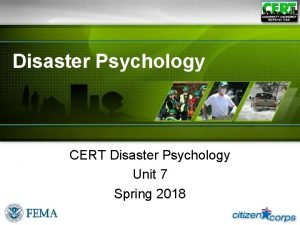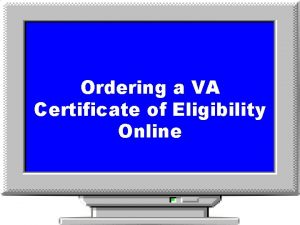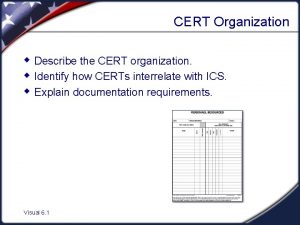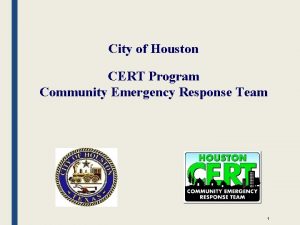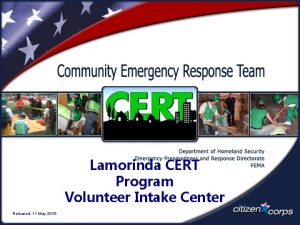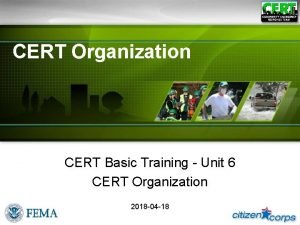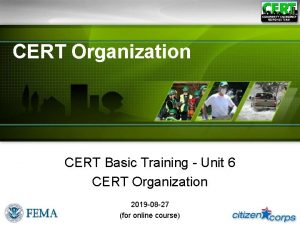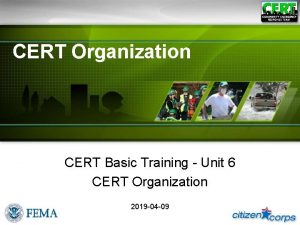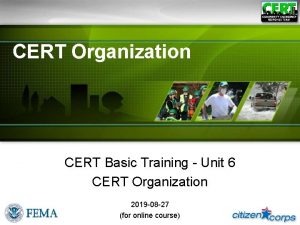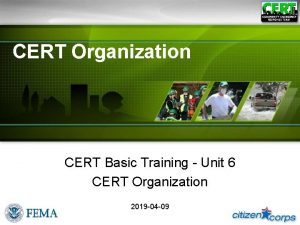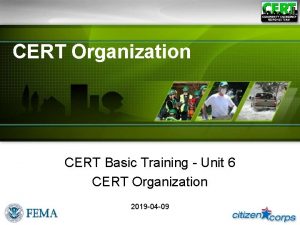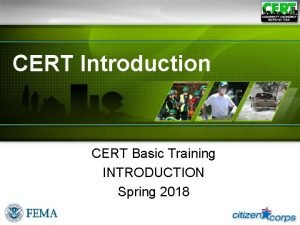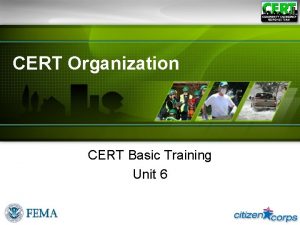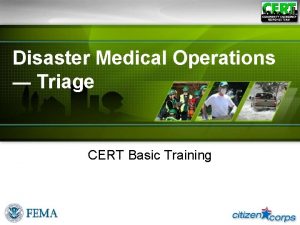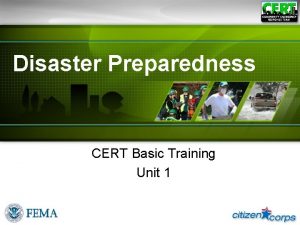CERT Animal Response I II CERT Animal Response









































































- Slides: 73

CERT Animal Response I & II

CERT Animal Response I

Module I Purpose The purpose of this module is to teach CERT members emergency preparedness for animal owners and how to recognize specific animal behaviors. Animal Response I 3

Animal-Related Emergency Functions Animal Response 4

Disaster Planning for Your Animals Animal Response 5

Preparing for a Disaster • Animal owners should prepare by: § § § Identifying potential hazards Mitigating the impact of hazards Creating a disaster plan Assembling disaster supplies Participating in training and exercises Knowing your community’s disaster response plan Animal Response 6

Identifying Potential Hazards • What types of disasters could occur in your community? § Natural § Technological § Terrorist • How could a disaster affect your animals? Animal Response 7

Mitigating the Impact of Hazards • Reducing the impact of disasters • Making changes that protect properties or • facilities Examples: § Encourage animal facilities to relocate out of disaster -prone areas § Encourage owners and animal facilities to have emergency plans, including evacuation plans Animal Response 8

Creating a Disaster Plan for Animals • Preparing to Evacuate Your Animal • Preparing to Stay at Home With Animals • • • During a Disaster Animal Care After a Disaster Preparations for Livestock Special Considerations for Exotic Animals Animal Response 9

Preparing to Evacuate Your Pet/Service Animal • Establish an out-of-area • • contact Identify where you will stay if evacuated Plan your evacuation routes Update vaccinations and ID tags Get a crate or carrier for each pet; train dogs to use it Animal Response 10

Preparing to Evacuate Your Pet/Service Animal • Gather evacuation supplies; include vaccination certs & pictures of you with your animals • Make a plan for evacuating without your pet (last resort!) – if it’s not safe for you, it’s not safe for your animals Animal Response 11

Preparing to Stay at Home with Animals • Bring pets inside • Have newspaper on hand • Be aware that animals may • • isolate themselves if afraid Separate dogs and cats Separate smaller pets away from cats and dogs Animal Response 12

Caring for Animals After a Disaster • Animal behavior may • • • change after a disaster Leash pets for the first few days Displaced wildlife may pose a threat to pets Downed power lines are another hazard Animal Response 13

Assembling a Disaster Supply Kit • Download a supply list from • • www. ready. gov Have enough basic supplies for every individual and pet to survive for at least 7 days Evacuation checklist Shelter-in-place checklist Post information for emergency personnel on your property Animal Response 14

Grouping Animals What do these animals have in common? Animal Response 15

Characteristics of Predator Animals Vision Feet Teeth Animal Response Instincts 16

Grouping Animals What do these animals have in common? Animal Response 17

Characteristics of Prey Animals Vision Feet Teeth Animal Response Instincts 18

Animal Domestication • Domesticated animals may revert to • • instinctive behavior Predator animals may chase and attack Prey animals may run or hide Animal Response 19

Dog Facial Expressions Increasing Aggression Increasing Fear Animal Response 20

Dog Body Language Animal Response 21

Dog Body Language (cont’d) Animal Response 22

Dog Body Language (cont’d) Animal Response 23

Dog Body Language (cont’d) Animal Response 24

Dog Body Language (cont’d) Animal Response 25

Dog Body Language (cont’d) Animal Response 26

Cat Body Language Confident Animal Response 27

Cat Body Language (cont’d) Relaxed Animal Response 28

Cat Body Language (cont’d) Anxious Animal Response 29

Cat Body Language (cont’d) Distance Increasing Animal Response 30

Cat Body Language (cont’d) Defensive Aggression Animal Response 31

Cat Facial Expressions Animal Response 32

Cat Tail Expressions Animal Response 33

Identifying Animal Behavior Animal Response 34

Identifying Animal Behavior (cont’d) Animal Response 35

Identifying Animal Behavior (cont’d) Animal Response 36

Identifying Animal Behavior (cont’d) Animal Response 37

Module I Summary • In this module, we reviewed: § Animal-Related Emergency Management Functions § Preparedness for Your Animals § General Animal Behavior Animal Response 38

CERT Animal Response II

Module II Purpose The purpose of this module is to ensure that CERT members can respond safely and appropriately in emergency events involving animals. CERT Animal Response II 40

CERT Responder Safety with Animals • This topic will cover: § § Encountering Animals Zoonotic Disease Transmission Injuries Caused by Animals Psychological Self-Care CERT Animal Response II 41

Responders’ Safety Priorities Always remember the responder’s safety priorities: 1. Yourself 2. Your teammates and bystanders 3. The subject CERT Tools for Leadership Success 42

Encountering Animals Size up the situation 1. 2. 3. 4. 5. Look for presence of owner Look for evidence of animals Consider local environment Be prepared for illegal animal activity Perform damage assessment CERT Animal Response II 43

1. Look for Presence of the Owner CERT Animal Response II 44

2. Look for Evidence of Animals CERT Animal Response II 45

3. Consider the Local Environment CERT Animal Response II 46

4. Be Prepared for Illegal Animal Activity CERT Animal Response II 47

5. Perform Damage Assessment CERT Animal Response II 48

Approaching an Unknown Dog • • Expect the unexpected Do not let dog block your escape Do not show fear Maintain relaxed posture; keep energy level low Control environment if possible Avoid direct eye contact Do not get near dog’s face CERT Animal Response II 49

Approaching an Unknown Dog (cont’d) • Try gaining dog’s confidence • Try to contain dog • Consider size of your team • Know your limitations CERT Animal Response II 50

The “Sit” Command • Say “Sit” firmly but • not loudly Hold your hand in a “Stop” gesture CERT Animal Response II 51

If a Dog Attacks • • In the event of any dog attack, call 911 immediately Use basic commands Put object or distance between yourself and dog Back away; do not run away If you fall, curl up and cover your head Do not scream or yell If dog latches on, protect your face CERT Animal Response II 52

Injuries Caused by Animals CERT Animal Response II 53

Psychological Self-Care • Working with animals can • • be emotional Responders may be affected by emotions of animal owners Do not push yourself beyond your physical & psychological limits Animals can also reduce stress See CERT Basic Training Unit 7 Disaster Psychology CERT Animal Response II 54

Knowledge and Skills Needed for CERT Functions Involving Animals • This topic will cover: § § § Cleaning and Disinfection General Animal Care Animal Handling Caring for Injured Animals Communicating with Animal Owners Animal Identification and Documentation CERT Animal Response II 55

Cleaning and Disinfection • Debris and organic material MUST be • • removed as soon as possible Clean with soap and water Apply a suitable disinfectant CERT Animal Response II 56

General Animal Care • Follow nutritional and environmental • • • requirements Not feeding animal is better than feeding wrong food; do not overfeed All animals need constant access to clean and potable water Store feed where animals can’t access CERT Animal Response II 57

Animal Handling: Dogs For non-aggressive dogs: • Avoid prolonged direct eye contact • Use a soft voice; keep your energy level low • Approach dog with your body turned sideways • Move toward the dog slowly • Use a slip leash to control the dog • Do not loom over dog • Do not grab dog by collar CERT Animal Response II 58

Animal Handling: Dogs (cont’d) • • For frightened dogs: § Seek assistance unless you are experienced § Don’t approach unless others can assist you; always use “buddy system” § Move slowly and try to get dog to come to you § When secure, towel over dog’s head can be calming Aggressive dogs: Call animal control or law enforcement CERT Animal Response II 59

Dog Restraints: Leashes • • • Use only if dog is not aggressive If given time, some dogs may calm down Keep dog calm as you slip on leash Slip leashes are best Improvise with rope, belt or twine CERT Animal Response II 60

Dog Restraints: Muzzles CERT Animal Response II 61

Dog Restraints: Standing 1. Place arm under dog’s neck and other arm behind rear legs 2. Pull dog’s head snugly against your shoulder CERT Animal Response II 62

Dog Restraints: Lateral CERT Animal Response II 63

Carrying Dogs CERT Animal Response II 64

Transporting Dogs • • • Make sure dog crates are adequate size Allow only one dog per crate Clean and disinfect crates between animals If not in cage, leash or tether dog inside vehicle Control climate within vehicle Keeping dogs in stationary vehicles in hot weather can result in death CERT Animal Response II 65

Animal Handling: Cats Approaching Cats • Speak slowly and softly • Approach with your side facing cat • Move slowly • Work with a partner CERT Animal Response II 66

Animal Handling: Cats (cont’d) Out-of-Control Cats • Back off and allow cat to calm down • Use double thick or armored gloves and eye protection • Attempt capture with fishing nets, blankets, or traps • If possible, let professional animal handlers do the job CERT Animal Response II 67

Transporting Cats • • Have owner present if possible Always wear heavy gloves Use towels to lift and carry Tap on cat food can to get cat to come to you Use as little restraint as needed Cats may be frightened by unexpected stimuli Cats become defensive easily Place cats in carriers for transporting CERT Animal Response II 68

Transporting Cats CERT Animal Response II 69

Caring for Injured Animals • Act within framework of CERT training • Perform sizeup • Be careful: Stressed animal may bite, scratch, • • • kick, or attack Restrain appropriately If unable to restrain, do not attempt first aid If possible, transport animal for professional help CERT Animal Response II 70

Communicating with Animal Owners • Understand • • • psychological strain on pet owners Refer to CERT Basic Training Unit 7 Disaster Psychology Don’t underestimate human-animal bond Provide emotional support for animal owners CERT Animal Response II 71

Animal Identification • Animals can be identified with: § § § § Tags Microchips Tattoos Ear tags Collars Bands on birds Branding on livestock • Some communities may have system for identifying dangerous animals CERT Animal Response II 72

Module II Summary In this module, we reviewed: • Your role as a CERT member in functions involving animals • Protecting your safety when dealing with animals • Knowledge and skills you will need for CERT functions involving animals CERT Animal Response II 73
 Cert animal
Cert animal Cert animal
Cert animal What is natural response
What is natural response A subsequent
A subsequent Natural response and forced response
Natural response and forced response Animal farm text response essay
Animal farm text response essay Pennsylvania state animal response team
Pennsylvania state animal response team Animal response to stimuli
Animal response to stimuli Animal rights versus animal welfare
Animal rights versus animal welfare Plant and animal cell venn diagram
Plant and animal cell venn diagram Plant animal cell venn diagram
Plant animal cell venn diagram Tae40110 cert iv in training and assessment
Tae40110 cert iv in training and assessment Hltpat001
Hltpat001 Cert train the trainer
Cert train the trainer Search and rescue light
Search and rescue light E-cert.eu
E-cert.eu Seamus heaney poems leaving cert
Seamus heaney poems leaving cert Lamorinda cert
Lamorinda cert Comparative question leaving cert english
Comparative question leaving cert english Cert bff
Cert bff Phytclean
Phytclean Formation of sedimentary rocks leaving cert
Formation of sedimentary rocks leaving cert Smart cert
Smart cert Tceq pi-7 cert
Tceq pi-7 cert Enisa cert
Enisa cert Wizard certificate
Wizard certificate Steps of accounting process
Steps of accounting process 9 step accounting cycle
9 step accounting cycle Cert disaster psychology
Cert disaster psychology Va cert of eligibility online
Va cert of eligibility online Cert.korcham.net/search
Cert.korcham.net/search History syllabus leaving cert
History syllabus leaving cert Cert coordination center
Cert coordination center Pcs optional subjects
Pcs optional subjects Montgomery bus boycott leaving cert
Montgomery bus boycott leaving cert Pcert postecert
Pcert postecert Poetic techniques junior cert
Poetic techniques junior cert Pytlák líčí past
Pytlák líčí past Accounting leaving cert notes
Accounting leaving cert notes Cash budgeting leaving cert
Cash budgeting leaving cert Lcpe
Lcpe Sing cert
Sing cert Dominic haugh leaving cert history
Dominic haugh leaving cert history Sylvia plath leaving cert questions
Sylvia plath leaving cert questions Cert organizational structure
Cert organizational structure Dur root words
Dur root words Elizabeth bishop leaving cert notes
Elizabeth bishop leaving cert notes Chapter 4 completion activity
Chapter 4 completion activity Poetic techniques
Poetic techniques Construction studies experiments
Construction studies experiments Cert asig
Cert asig Leaving cert history
Leaving cert history Factor theorem leaving cert
Factor theorem leaving cert Philip curry business
Philip curry business Leaving cert business abbreviations
Leaving cert business abbreviations Buildingcert
Buildingcert Cert organizational structure
Cert organizational structure The lake isle of innisfree notes leaving cert
The lake isle of innisfree notes leaving cert Cert
Cert Music technology leaving cert
Music technology leaving cert Houston cert
Houston cert Regional geography leaving cert
Regional geography leaving cert Denton county cert
Denton county cert Melody writing leaving cert
Melody writing leaving cert Elizabeth bishop poses interesting questions
Elizabeth bishop poses interesting questions Chcccs
Chcccs Leaving cert religion
Leaving cert religion Nitrogen cycle diagram leaving cert
Nitrogen cycle diagram leaving cert Leaving cert lce
Leaving cert lce Lamorinda cert
Lamorinda cert Respiration experiment leaving cert
Respiration experiment leaving cert Methods of promoting intrapreneurship leaving cert
Methods of promoting intrapreneurship leaving cert Ed 126 form
Ed 126 form Lc english paper 1 timing
Lc english paper 1 timing
